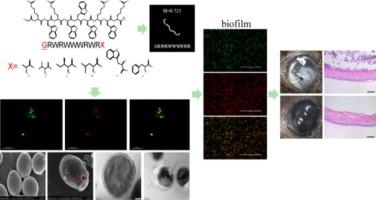当前位置:
X-MOL 学术
›
J. Adv. Res.
›
论文详情
Our official English website, www.x-mol.net, welcomes your
feedback! (Note: you will need to create a separate account there.)
Optimizing therapeutic efficacy of antifungal peptides via strategic terminal amino acid modification
Journal of Advanced Research ( IF 11.4 ) Pub Date : 2024-09-23 , DOI: 10.1016/j.jare.2024.09.017 Jing Song, Shanshan Zhang, Junya Xing, Licong Zhang, Jiajun Wang, Anshan Shan
中文翻译:

通过策略性末端氨基酸修饰优化抗真菌肽的治疗功效
抗真菌肽(AFP)具有治疗抗真菌耐药性感染的潜力;然而,它们的结构与功能关系仍然未知,阻碍了它们的快速发展。因此,研究和阐明AFP的结构与功能关系势在必行。
更新日期:2024-09-23
Journal of Advanced Research ( IF 11.4 ) Pub Date : 2024-09-23 , DOI: 10.1016/j.jare.2024.09.017 Jing Song, Shanshan Zhang, Junya Xing, Licong Zhang, Jiajun Wang, Anshan Shan

|
Introduction
Antifungal peptides (AFPs) have the potential to treat antifungal-resistant infections; however, their structure–function relationship remains unknown, hindering their rapid development. Therefore, it is imperative to investigate and clarify the structure–function relationships of AFPs.Objectives
This study aimed to investigate the impact of end-tagging single hydrophobic amino acids and capping the N-terminus with glycine (Gly) on the antifungal activity of peptide W4.Methods
The antifungal efficacy of the engineered peptides was initially assessed by determining the minimum inhibitory concentration (MIC) /minimal fungicidal concentration (MFC), killing kinetics, and drug resistance induction, in addition to evaluating the biocompatibility and stability. Subsequently, the antifungal mechanism was investigated using fluorescence labeling, electron microscopy, reactive oxygen species (ROS) detection, and measurement of mitochondrial membrane potential and apoptosis. The impact of the engineered peptides on Candida albicans (C. albicans) biofilm and their potential application in the scratch keratomycosis model were investigated.Results
The antifungal activity of W4 was significantly enhanced by capping Gly at the N-terminus, resulting in a decrease in average activity from 11.86 μM to 6.25 μM (GW4) and an increase in TI values by 1.9-fold (TIGW4 = 40.99). Mechanistically, GW4 exerted its antifungal effect by disrupting the cellular membrane structure in C. albicans, forming pores and subsequent leakage of intracellular contents. Concurrently, it facilitated intracellular ROS accumulation while decreasing the mitochondrial membrane potential. Additionally, GW4 demonstrated an excellent ability to inhibit and eliminate biofilms of C. albicans. Notably, GW4 demonstrated significant therapeutic potential in a C. albicans-associated keratitis model.Conclusion
Capping Gly at the N-terminus increased residue length while significantly enhancing the helical propensity of W4, thereby augmenting its antifungal activity. Our exploratory study demonstrated the potential strategies and avenues for optimizing the structure–function relationships of AFPs and developing highly effective antifungal drugs.中文翻译:

通过策略性末端氨基酸修饰优化抗真菌肽的治疗功效
抗真菌肽(AFP)具有治疗抗真菌耐药性感染的潜力;然而,它们的结构与功能关系仍然未知,阻碍了它们的快速发展。因此,研究和阐明AFP的结构与功能关系势在必行。











































 京公网安备 11010802027423号
京公网安备 11010802027423号